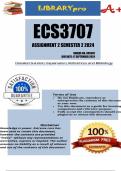Exam (elaborations)
ECS3707 Assignment 3 (ANSWERS) Semester 2 2024 (895997) - DUE 17 September 2024
- Institution
- University Of South Africa
ECS3707 Assignment 3 Full Solutions Semester 2 2024 (895997) - DUE 17 September 2024 ;100 % TRUSTED workings, Expert Solved, Explanations and Solutions. For assistance call or W.h.a.t.s.a.p.p us on ...(.+.2.5.4.7.7.9.5.4.0.1.3.2)........... QUESTION 1 [40 MARKS] Critically assess the merits of u...
[Show more]



